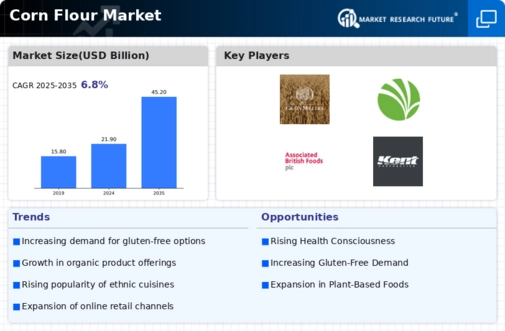Market Trends
Key Emerging Trends in the Corn Flour Market
In the competitive landscape of the corn flour market, effective market share positioning strategies are essential for companies to differentiate themselves, attract customers, and sustain growth. One key strategy is product differentiation based on quality and purity. Corn flour manufacturers can distinguish their products by emphasizing superior quality, purity, and nutritional value. By sourcing high-quality corn and employing advanced processing techniques, companies can produce corn flour with a finer texture, better flavor, and enhanced nutritional profile, appealing to health-conscious consumers seeking wholesome and natural ingredients.
Moreover, targeting specific consumer segments can be an effective market share positioning strategy for corn flour manufacturers. By identifying niche markets such as gluten-free, organic, or non-GMO consumers, companies can tailor their product offerings and marketing messages to meet the unique needs and preferences of these segments. For example, positioning corn flour as a versatile ingredient suitable for gluten-free baking or as a sustainable option for environmentally conscious consumers can help companies capture market share within these growing segments.
Furthermore, strategic partnerships and collaborations can provide valuable opportunities for market expansion and differentiation in the corn flour market. Collaborating with food manufacturers, retailers, or foodservice providers can increase brand visibility, access new distribution channels, and introduce innovative product formulations or packaging formats. For instance, partnering with a bakery chain to develop exclusive corn flour-based recipes or co-branding with a popular chef to promote corn flour as a versatile culinary ingredient can help companies gain a competitive edge and expand their market share.
Additionally, geographic expansion and localization can play a significant role in market share positioning for corn flour manufacturers. By establishing production facilities or distribution networks in key regions with high demand for corn-based products, companies can optimize supply chain efficiency, reduce transportation costs, and better serve local markets. Moreover, adapting product formulations or packaging sizes to suit regional preferences and culinary traditions can enhance the appeal of corn flour to diverse consumer demographics, driving market penetration and increasing market share.
Furthermore, investing in research and development (R&D) to innovate new product formulations or value-added offerings can be a strategic approach to gain market share in the corn flour market. Developing specialty corn flour varieties with unique flavor profiles, enhanced nutritional benefits, or functional properties can differentiate products from competitors and create opportunities for premium pricing. Additionally, investing in packaging innovation, such as resealable bags or portion-controlled packaging, can enhance convenience and appeal to consumers seeking easy-to-use and storage-friendly products.
Moreover, leveraging digital marketing and e-commerce channels can be a cost-effective way to reach target consumers and increase market share in the corn flour market. Establishing a strong online presence through websites, social media platforms, and e-commerce marketplaces allows companies to engage with consumers directly, showcase product benefits, and facilitate convenient purchasing experiences. Moreover, implementing targeted advertising campaigns, influencer partnerships, and online promotions can increase brand visibility, drive traffic to online storefronts, and generate sales growth.
Additionally, pricing strategies play a crucial role in market share positioning for corn flour manufacturers. Offering competitive pricing relative to competing products in the market can attract price-sensitive consumers and stimulate demand. Moreover, implementing pricing strategies such as bundling, volume discounts, or promotional pricing can incentivize larger purchases and encourage repeat business, further increasing market share. Furthermore, implementing dynamic pricing algorithms that adjust prices based on supply and demand dynamics or seasonal fluctuations can help optimize revenue and profitability while remaining competitive in the market.







Leave a Comment